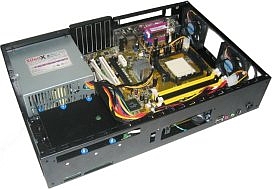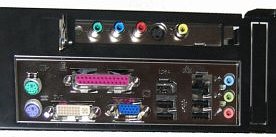DIY Linux home theater PC
Aug 28, 2006 — by LinuxDevices Staff — from the LinuxDevices Archive — 6 views LixSystems has introduced a low-cost Linux powered home theater PC (HTPC) packaged in a compact, consumer electronics-style enclosure. The Lx8100-MN, available “barebones” (sans CPU, memory, and hard drive) for around $300, offers quiet operation and is supplied with an easily-installed Fedora 5-based system image on DVD,… according to the company.
LixSystems has introduced a low-cost Linux powered home theater PC (HTPC) packaged in a compact, consumer electronics-style enclosure. The Lx8100-MN, available “barebones” (sans CPU, memory, and hard drive) for around $300, offers quiet operation and is supplied with an easily-installed Fedora 5-based system image on DVD,… according to the company.

The LX8100-MN has a consumer electronics look
digg this story |
The LX8100-MN comes with a Linux installation DVD that is meant to simplify the installation of virtually all required software on the device, once the user has outfitted the system with a processor, memory, and disk drives.
The installation DVD's Linux OS image includes a Fedora 5-based 2.6.16 Linux kernel, along with an extensive set of drivers as well as support for support for USB, card reader audio, a “fully configured LIRC” (Linux Infrared Remote Control) receiver that works with the included handheld remote control, and a set of HTPC-oriented applications.
HTPC applications included on the installation DVD, according to LixSystems CTO Andy Miller, include KDETV, an open source TV viewer; TV-Time, another open source TV viewer; and KRadio, an open source AM/FM radio front-end.
Notably, MythTV PVR (personal video recorder) software is not included. Miller says the company omitted MythTV due to concerns regarding potential copyright infringement issues, especially with respect to mpeg2 and other codecs. However, everything in the system image contained on the DVD has been configured to be MythTV-friendly, to ensure that users have as little trouble as possible in getting their HTPC system up and running, he adds.
Miller says that the following component and drivers are “guaranteed to work” when using the installation DVD:
- Networking
- Graphic card 3D drivers with support for TV-out with over-scan correction (SVideo and composite video), VGA, DVI, and Component Video
- LIRC, works with the included remote and emulates a mouse under X.
- SATA, USB, and 1394 interfaces
- MPEG hardware acceleration (XvMC)
- SAA7134/7131-based TV capture cards
Installation process
According to Miller, the basic steps required to create a ready-to-use Linux-based HTPC starting from the bare-bones Lx8100-MN, are:
- Install a processor, memory, hard drive, and DVD/CD-RW drive
- Install a video capture / TV card — anything based on the SAA-7134 chipset is likely to work, Miller says (typical cost under $50)
- Insert the Linux OS image DVD that comes with the system into the DVD drive and power up — the system installs on the hard drive in “as little as 15 minutes,” Miller says
- Type “yum install mythtv-suite” at the Linux command line, to download/install MythTV software

The installation DVD boots into a 2.6.16 kernel
(Click to enlarge)
The hardware

The system, which is packaged in a 16 x 3 x 11 inch enclosure, offers the following hardware features, according to LixSystems:
- Supported processors — AMD Socket AM2, compatible with Athlon 64 X2, Athlon 64 FX, Athlon 64, Sempron
- Memory — 4 x 240-pin DIMM; supports up to 8GB DDR2 ECC/non-ECC unbuffered
- Graphics:
- Integrated GeForce 6 GPU
- DVI out
- VGA out
- Component Video out
- High-definition video supports resolutions to 1920 x 1440 @ 75Hz
- Audio:
- Based on ADI AD1986A
- Supports high-definition audio
- Supports jack-sensing and S/PDIF out
- 8 x USB 2.0 ports
- IEEE 1394 port
- Gigabit Ethernet port
- Expansion slots:
- 2 x PCI
- 1 x PCI Express x16
- 1 x PCI Express x1
- 280 watt power supply with “ultra-quiet” (14 dBA) fan

Rear panel I/O
Availability
Two versions of the LixSystems HTPC appear to be available: a barebones system, priced at $299; and a “fully configured” system, which includes an AMD Sempron 64 3000+ processor, 250GB hard drive, 512MB memory, a TV/radio/video-capture card, and a DVD/CD-RW drive, for $549. Further details are on the company's website.
Additionally, the Linux OS installation disk, which will work with various ASUS motherboards, according to Miller, can be downloaded free of charge, here.
This article was originally published on LinuxDevices.com and has been donated to the open source community by QuinStreet Inc. Please visit LinuxToday.com for up-to-date news and articles about Linux and open source.